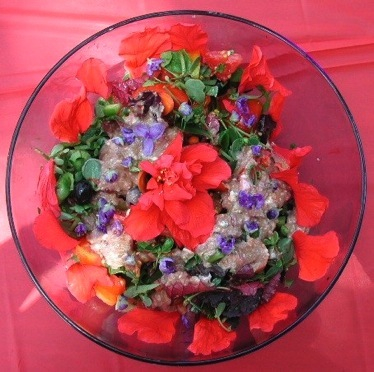
A true back yard salad, a hibiscus blossom is the center piece and decorations around the edge. The light blue flowers are tradescantias. (See Pocahontas entry) There are also bits of deep red H. acetosella leaves in the salad as well along with purslane (see omega 3 fatty weed entry.) The dressing is blackberry yogurt with balsamic vinegar and olive oil
Lunch Landscaping: Hibiscus
My mother’s favorite flower was the Rose of Sharon, which of course didn’t even go in one of my ears and out the other when I was a kid. But now that she’s passed (at 88) and I like plants I pay more attention. The Rose of Sharon is Hibiscus syriacus (high-BISS-kuss seer-ee-AY-kuss) meaning “slimy from Syria.” It’s a mallow family member and besides mom’s favorite it happens to be the national flower of South Korean, fitting since the flower is an Asian native. (They first thought it came from Syria, hence the name.)
In Korean, H. syriacus is called mugunghwa, which is a variation of the word mugung, meaning “immortality.” H. syriacus is also called the Rose of Althea, which is from Greek meaning “truth.” Actually, hibiscus is also a Greek word. More on that in a moment. H. Syriacus is a flower that has prompted folks to be poetical for a long time. And regardless of what it is called, the hibiscus is a mallow and people have been using plants in the mallow family for a very, very long time.
Mallows are quite consistent in their signature flower: Five separate petals with the male and female parts fused together like a frilly spike in the center, typified by the top left picture of a hibiscus taken in Greece at the cave of St. John, on Patmos. Some part of a Mallow is usually mucilaginous, meaning slimy. Crush almost any part of the plant and rub it between your fingers, they will be slimy or sticky.
The medicinal properties of the wet-footed low-growing marsh mallow were mentioned by Horace, Virgil, Dioscorides and Pliny (and from whence where the original marshmallow of peanut butter sandwich fame came from.) The Egyptians and the Chinese used the mallow. It was even mentioned in the Bible, book of Job, 30: 3-4: “For want and famine they were solitary; fleeing into the wilderness in former times desolate and waste. Who cut up mallows by the bushes, and juniper roots for their meat.”
Pythagoras, the Greek philosopher and mathematician, advised against eating the marsh mallow because it was, in Greek theology, the first messenger sent to earth by the gods to show their sympathy with the short lives of mortals. Thus eating mallow would dishonor the gods. The word mallow itself comes from the Anglo Saxon word Malwe. That came from the Greek malakos, for soft. Even Shakespeare mentions mallows, in The Tempest. Gonzalo is saying “Had I plantation of this Isle, my lord…” when he is interrupted by Antonio and Sebastian saying: “He would sow it with nettle-seed. Or docks or mallow.”
The most common form of mallow most folks see these days is the hibiscus, and that’s what is pictured on this page. It’s a very common landscape shrub in warm areas and at least one species— Malvaviscus arboreus (mal-vah-VIS-kus ar-BOR-ee-us) the tubular flower to the right —has escaped cultivation and naturalized. It is also called Malvaviscus penduliflorus.
I usually put hibiscus flowers in salads. They don’t have any flavor but they are pretty and add texture. The leaves of some hibiscus are edible as well, such as pink hibiscus with red leaves on this page, upper right. Called the False Roselle, its Latin name is Hibiscus acetosella (hye-BISS-kus uh-set-o-. SEL-luh.) As mentioned, hibiscus means hibiscus or slimy or sticky, and acetosella means “a little sour.” Besides the flowers of the H. acetosella, I use the young leaves for salads and stir fry. A close relative, H. sabdariffa (hye-BISS-kus sab-duh-RIF-fuh) is the real roselle and is also known as the “Florida Cranberry” the “Cranberry Hibiscus” and the Jamaican Sorrel, thought the latter strikes me as recent and nescient. A tart juice can be made from its fat calyxes and it’s something of a tradition in the West Indies. Many posters on the internet get these two hibiscus mixed up, but there is no need for it. The False Roselle ( H. acetosella) resembles a small red maple where as the Cranberry Hibiscus (H. Sabdariffa) has lance-shaped, green leaves. They look quite different in leaf shape and color.
Better known members of this family today are okra and cotton. Cotton is the only mallow with proven toxic properties. While refined cottonseed oil is common — the basis for Crisco shortening (the names comes form Crystalized Cotton Seed Oil) in its raw state it reduces potassium in the body and increases infertility. Oddly it is also often used to pack smoked oysters.
As for okra many folks don’t like its viscus texture but it brings up the origin of words. Viscus and hibiscus come from the same Greek word, “iviscos” which means hibiscus and has come to mean thick or sticky as in a viscous fluid. The base word in Greek is EE-vis, a marsh wading bird still found in English as Ibis.
While the nutritional value of the H. acetosella (the pink one with the red leaves) is not known, here is the nutritional breakdown of a close, edible relative:
Flowers (Fresh weight) Water: 89.8 Protein: 0.06 Fat: 0.4 Fiber: 1.56 Calcium: 4 Phosphorus: 27 Iron: 1.7 Thiamine: 0.03 Riboflavin: 0.05 Niacin: 0.6 Vitamin C: 4.2
Fruit (Dry weight) Calories: 353 Protein: 3.9 Fat: 3.9 Carbohydrate: 86.3 Fiber: 15.7 Ash: 5.9 Calcium: 39 Phosphorus: 265 Iron: 17 Thiamine: 0.29 Riboflavin: 0.49 Niacin: 5.9 Vitamin C: 39,
Leaves (Dry weight) Protein: 15.4 Fat: 3.5 Carbohydrate: 69.7 Fiber: 15.5 Ash: 11.4 Calcium: 1670 Phosphorus: 520
One mallow is a famine food, the Caesar Weed, see an article elsewhere here on the Caesar Weed, Urena lobata. Also edible is the leaves of the Abelmoschus manihot.Two final nibblettes: Some times marsh mallows are called cheeses That’s because the flat, round, seed pod of the marsh mallow looks something like cheese. And, the mineral malachite is named after the mallow because its green color is similar to the mallow green.
Green Deane’s “Itemized” Plant Profile
IDENTIFICATION: The leaves are alternate, simple, oval to lance shaped, often with a toothed or lobed. The flowers are large, obvious, trumpet-shaped, with five or more petals, ranging from white to pink, red, purple or yellow. The fruit is a dry five-lobed capsule, containing several seeds in each lobe.
TIME OF YEAR: Can bloom year round in warm areas.
ENVIRONMENT: H. acetosella prefers most well-drained soil. It cannot grow in the shade. It requires moist soil.
METHOD OF PREPARATION: Flowers and young leaves of the H. acetosella can be eaten raw, chopped leaves an be added to stir fries.

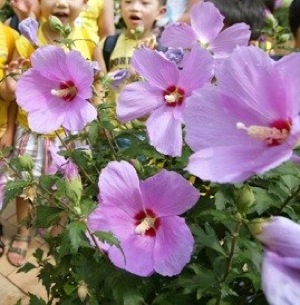
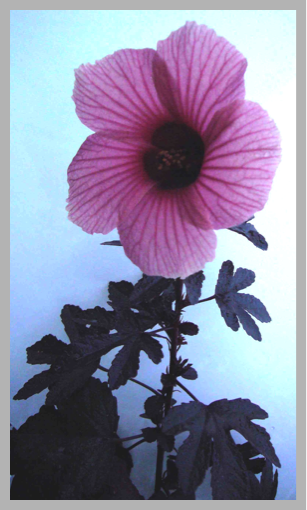


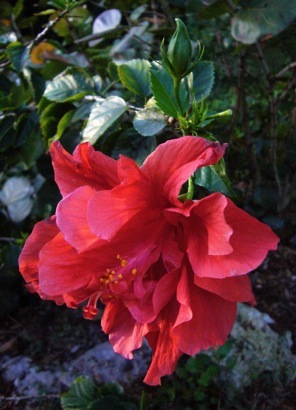
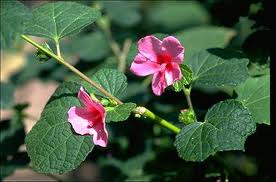


Hello Mr. Deane,
I am planning a “forager’s garden” in which I propagate native edible plants, from available seed, so I may more easily identify them in the wild. I live in northwestern Iowa and want to experiment with mallows such as Callirhoe bushii and Hibiscus militaris/laevis. I’ve read a couple books and I know the multiple liability warnings but does “Cotton is the only mallow with proven toxic properties.” mean I can treat any other Malvales Malvaceae as one would Althaea officinalis?
Thanks,
Nich
No. The mallows have different edible parts. Sometimes the leaf, some times the root et cetera. Each one has to be treated individually.
I have been trying to find out if this same species (Hibiscus militaris/laevis) is edible and what part, but I haven’t been able to find any information on it yet. Do you know anything about it and what its specific characteristics are?
Thanks!
I am not personally familiar with the species. However, it’s a fairly safe genus. That said Foraging Texas does show Hibiscus militaris. I would not think it there unless it were edible in some way.
Hello Green Dean,
I just saw a bunch of Rose of Sharon in Gemini springs. How do you use it.
If it is Hibiscus syriacus leaves are eaten or used as a tea substitute and the flowers are edible.
Hi Green Deane!
I’m reading up on plants that are edible for parrots and chickens, and I read that the rosa-sinensis species is. However, we have a Fireball Hibiscus–which, according to the internet, is a hybrid–but no one seems to know the scientific name for it, merely that it’s a ‘Fleming.’ So, I was wondering if you knew the specific species of the Fireball Hibiscus. (I really don’t want to make a mistake.)
Thanks,
Julie
It’s a varaition of Hibiscus moscheutos.
http://www.daytonnursery.com/encyclopedia/perennials/hibiscus.htm
Hi Greene Deane,
Being a transplant to Florida, I love your site! It’s so fun to know about the edibles here. I have a couple false roselles, which my kids love to nibble on as they walk through the yard. We also have fun making a tea out of the leaves, which resembles cool-aid, with it’s bright red/pink color. I was wondering if you’ve ever heard of (or made yourself) jelly from the leaves? I’m thinking I’m going to try it, but can’t find anyone else who has. (We loved the beauty-berry jelly, btw!)
Do you know how the false roselles do up north? I’m sending some seeds to my mom in Kansas – seems like mine became out-of-control huge in one summer, but the soil there is definitely different than here.
Thanks for all your work! 🙂
Tabitha
The false roselle will grow nicely in warm weather but any kind of freeze, including the winter time ground, will kill them. You could, however, take cuttings and over winter them in sunny glass containers. They root happile and will live a long time injust water.
How wonderful to see this info on Mallows…THANK YOU.
I also grow/eat and sell a bit of excess weeds (along with standard greens) to friends who love greens in smoothies. One of my all time favorite greens is the common garden mallow…a weed. Acutally I have a one step up better plant than that weed. I bought the seed as an Heirloom originally called “Zebra Mallow” for its 1″-1 1/2″ pink/purple striped hollyhock type flower. This plant is shorter than hollyhocks and the leaf does not get a big. But its much bigger and more beautiful, last in production longer than the common garden mallow. This plant is delicious cooked and raw in smoothies. I am wondering if you have info or experieince with it. I am into trading seeds for those intersted.
i would love some seeds. i have some seeds from a gourd that came from africa. It is too rainy and wet here to grow them for me so far, but i am thinking i will try in the plastic greenhouse later this year.
would you like a few? i don’t know their name, but i can see about getting a picture of the gourd (very large and carved with animals) to you.
Candace, and others IF you like unique flowers Kankakee Mallow (Iliamna remota ) In Northern Illinois is said to be very rare.
Your In CA , but Hopefully these will be sought after to preserve them, by others.
(Nice site Candace by the way)
(Note I live not far from Kankakee IL it’s out side of Chicago (S)
I plan to grow this , and maybe Since I’ve heard from old homesteaders grow them out by the Out house (of people I know)
So the ladies can ask where are the Holly Hocks, and not where is the Out house, and maybe I too will have something rare to trade others In IL.)
http://www.illinoiswildflowers.info/savanna/plants/kk_mallow.html
after all the “persecution” and negative feedback I get for my herbal beliefs its nice to see another person with some common sense who recognizes where all this beauty came from in the first place, adam and eve were created in the garden of eden for a reason. thanks for sharing all your herbal wisdom dean, I look forward to your newsletters to educate me in survival. I love this site.
Hi Green Deane, you mentioned Turk’s cap mallow in this article but didn’t specify which, if any, part of this plant is edible? There’s a huge patch growing near me and I’d like to nibble on it.
On a related note, I noticed you call this plant Malvaviscus arboreus, though I’ve also seen M. penduliflorus used. One source said the latter is synonymous to “M. arboreus var. penduliflorus”. So is one a subspecies of the other or are they distinct? And does this affect their potential edibility?
Thanks a bunch, and I love your site. Can’t wait to go on another one of your guided hikes.
All the red flower parts of the Turks Cap are edible.
hi there and thank you very much in advance for all the information available in your website
it is winter here in the UK, there are quite a few primroses growing every where in green areas…
…are all primroses edible?? or put it in another way, is there any toxic primrose we need to be careful about
thanks
It depends on what primrose you are referring to.
It depends on which primrose you mean as several plants have that common name.
thanks for your promt reply….very true, i should have been more specific
i was reading about the primula vulgaris… an edible one
then i noticed many other primroses being planted in the parks during the winter (i think they are also primula but not sure) and wonder whether those garden primroses were also edible
thanks
So are all parts of the Hibiscus Moscheutos edible? Do you happen to have a reference to the dietary specifics of this plant?
Thank you! Awesome site!
No, but the mallows tend to be low on everything.
Hello, thanks for this article, its the most info Ive found about mallows and their edibleness(is that even a word) so far.
Anyways, I have some ornamental plants that have been around since the 1920s/30s on my property, and I believe they are “Malva sylvestris”, they have purplishpink petals with the striping.
I just want confirmation from somebody who knows what they are talking about that these are safe flowers to give to my parrots, please 🙂
I also have just planted 2 varieties each of Hibiscus “tradewinds” and “Bahama Bay”, as I am under the impression that these are also safe flowers to give to my parrots?
Thankyou so much, Im glad I found this article 🙂
Hello, any info on Great Red Hibiscus/Scarlet Swampmallow – Hibiscus coccineus being edible or tasty?
All Hibiscus blossoms are edible.
Reading your article, I stopped dead in my tracks when you referred to a Bible verse that refers to mallow. I try to record anything in the Bible that refers to plants. After much research, it appears that the mallow that this scripture is talking about is actually sea purslane. Mallows [N] [S]
occurs only in Job 30:4 (RSV, “saltwort”). The word so rendered (malluah, from melah, “salt”) most probably denotes the Atriplex halimus of Linnaeus, a species of sea purslane found on the shores of the Dead Sea, as also of the Mediterranean, and in salt marshes. It is a tall shrubby orach, growing to the height sometimes of 10 feet. Its buds and leaves, with those of other saline plants, are eaten by the poor in Palestine. Just thought I would pass that on. =)
And I do think that the lazy Hibiscus blooms do have taste. What I find amazing to me is that the young leaves taste like the petals of the bloom. I am thrilled to use both parts of the plant. I have a massive bush and when I trim it back every year, I find that the branches are excellent for making trellis or or there projects that need sturdy small branches. Thank you for your newsletters and articles !!!!
You freely give us the incredible gift of getting to know our birthright as human beings, the birthright of the plants that feed and heal, all around us, everyday. Thanks Dean for a wonderful treatise on mallows
I live in an area of south africa called the hibiscus cigar. The fun part of drinking red flower hibiscus tea is that when you add a drop of lemon, it turns bright pink
I live in an area of south africa called the hibiscus coast. The fun part of drinking red flower hibiscus tea is that when you add a drop of lemon, it turns bright pink